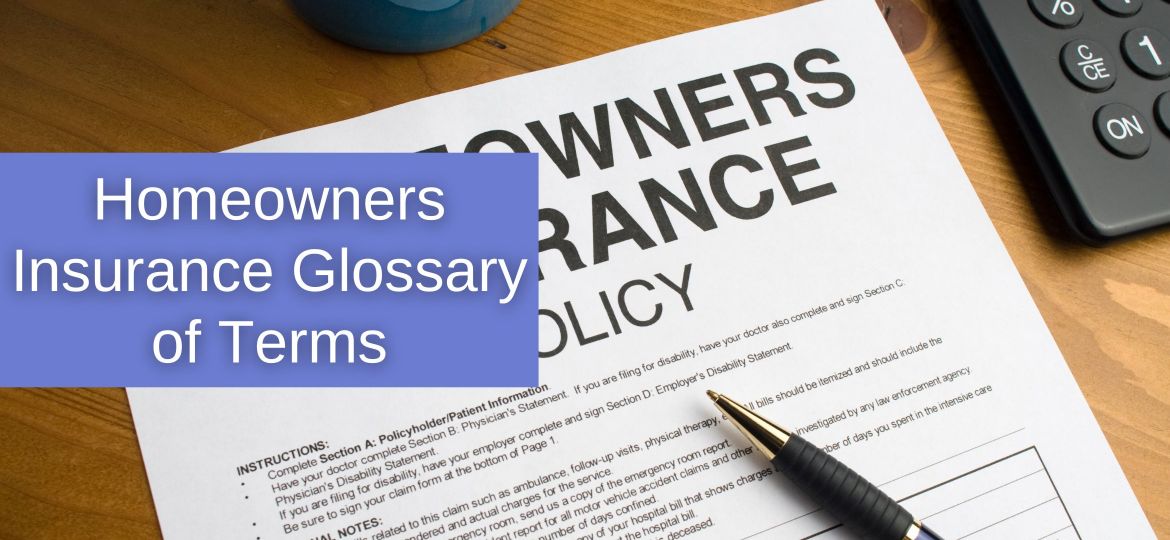
Most people don’t think much about homeowners insurance terminology—until it becomes something they need to understand quickly. Whether you’re purchasing a home, choosing the right insurance policy, or taking steps to protect your property over time, knowing these terms can make a big difference in avoiding confusion and financial surprises.
You might be wondering what the “80% rule” really means, or trying to figure out the differences between HO1 and HO3 policies. Maybe you’ve heard you need to add a rider to protect a special item, or you’re considering something called umbrella insurance. All of these decisions rely on understanding the language of homeowners insurance.
This glossary breaks down essential terms and includes real-world examples to help make these concepts clearer and more applicable to your own situation.
Homeowners Insurance Glossary
Appraisal
A formal assessment of your home’s market value, often required by insurers to determine how much coverage you need.
Example: Before setting your policy’s coverage limits, your insurer asks for an appraisal to confirm your home’s value.
Assessed Value
The value your local tax authority assigns to your property for tax purposes.
Example: Your home is assessed at $250,000, which forms the basis for calculating your annual property taxes.
Attractive Nuisance
A potentially dangerous feature on your property that might entice children and increase your liability.
Example: A swimming pool, even if fenced, is considered an attractive nuisance and can increase your risk exposure.
Binder
A temporary document that serves as proof of insurance coverage until the full policy is finalized.
Example: You’re required to provide a binder at your home’s closing to show the lender that the property is insured.
Blanket Insurance
A type of policy that offers combined coverage for multiple properties or valuable items under a single limit.
Example: If you own both a primary residence and a rental unit, blanket insurance can cover both under one umbrella policy.
Catastrophic Coverage
Additional protection designed for low-probability but high-impact disasters, such as earthquakes or hurricanes.
Example: If you live in an earthquake-prone area, standard homeowners insurance may not be enough—you’d need catastrophic coverage to handle those risks.
Claim
A formal request made to your insurance provider asking for payment for a covered loss or damage.
Example: After a hailstorm damages your roof, you submit a claim to get reimbursed for the repair costs.
Comprehensive Coverage
A broad policy option that protects against a wide variety of potential losses or damages.
Example: Comprehensive coverage doesn’t just include fire or theft—it often covers many other types of risks as well.
Coverage A (Dwelling Coverage)
This covers damage to the structure of your home itself.
Example: If a fire destroys your house, this part of your policy pays to rebuild it.
Coverage B (Other Structures)
Insurance for detached structures on your property, such as sheds or garages.
Example: Your backyard gazebo gets damaged in a storm—Coverage B steps in to help with repairs.
Coverage C (Personal Property)
Covers the personal belongings inside your home.
Example: If a break-in occurs and your electronics are stolen, this coverage helps you replace them.
Coverage D (Loss of Use)
Pays for your living expenses if your home becomes uninhabitable due to a covered event. This includes additional living expenses (ALE), such as hotel stays or temporary rentals.
Example: After a tornado makes your home unlivable, you stay in a rental property. This coverage reimburses those costs.
Deductible
The amount of money you’re responsible for paying out-of-pocket before your insurance starts to cover a loss.
Example: If your deductible is $1,000, and a storm causes $5,000 in damage, you pay the first $1,000 and the insurer covers the rest.
Depreciation
The decrease in value of items over time due to age, wear, or usage.
Example: That ten-year-old couch isn’t worth what you originally paid—its current value reflects depreciation.
Eco Insurance
Optional coverage that supports rebuilding with environmentally friendly or energy-efficient materials.
Example: If a windstorm wrecks your roof, eco insurance could help cover the cost of upgrading to solar panels instead of reinstalling traditional shingles.
Endorsement (Rider)
An add-on to your base policy that increases protection for specific items or circumstances.
Example: You purchase an endorsement to ensure your diamond engagement ring is fully covered in case it’s lost or stolen.

Escrow
A special account where your mortgage lender holds money to cover property taxes, insurance premiums, and PMI.
Example: A portion of your monthly mortgage payment goes into escrow to cover your annual tax and insurance obligations.
Exclusion
Anything that your policy specifically does not cover.
Example: Standard policies usually don’t include flood damage—you’d need to purchase separate flood insurance.
Floater Policy
A separate insurance policy offering full protection for especially valuable or portable items.
Example: You take out a floater policy to fully insure your $5,000 luxury watch against loss, theft, or damage.
Flood Insurance
A separate policy required for protecting your home against water damage caused by flooding.
Example: When your basement floods during heavy rainfall, standard insurance won’t help—but flood insurance will.
Hazard Insurance
Covers damage caused by certain events like fires, lightning, or windstorms—often included in standard homeowners insurance.
Example: A lightning strike damages your roof, and hazard insurance helps pay for the repairs.
HO-1 Policy
This is the most basic form of homeowners insurance and offers protection only for specifically listed perils.
Example: If a pipe bursts and damages your home, coverage would only apply if that kind of incident is explicitly named in the policy.
HO-3 Policy
A commonly used homeowners policy that covers your home against all perils except those specifically excluded.
Example: If a storm causes a tree to fall on your house, an HO-3 policy generally covers the repairs, unless falling trees are excluded.
Independent Insurance Agent
A licensed professional who can provide quotes and sell policies from various insurance companies, rather than being restricted to one provider.
Example: By working with multiple insurers, an independent agent can help you compare coverage options and pricing to find what fits your needs best.
Inflation Guard
A policy feature that automatically increases your coverage amounts over time to account for inflation and rising construction costs.
Example: If building materials and labor costs go up year after year, your policy adjusts so you’re still properly covered if you need to rebuild.
Insurance Fraud
When someone intentionally misleads or lies to an insurance company to receive an undeserved payout. This can include staged incidents, fake damage, or exaggerated losses.
Example: A homeowner sets fire to their own property and files a claim pretending it was accidental, aiming to collect insurance money.
Insurance Score
A numerical score based on factors like credit history and past insurance claims, which insurers use to help determine premiums.
Example: A higher score often leads to lower premiums, as it signals less risk to the insurer.
Insured
The person, people, or entity named on the insurance policy who are entitled to the benefits and protections the policy provides.
Example: If you own your home and hold the policy in your name, you are the insured and would receive support if there’s a covered loss.
Liability Coverage
Protects you financially if someone gets hurt on your property or if you’re legally responsible for damage to someone else’s property.
Example: If a visitor slips on an icy walkway at your home, liability coverage can help pay their medical bills or legal fees.
Loss Assessment Coverage
Offers protection for homeowners who share ownership of common areas through a homeowners association or condo board.
Example: If a community clubhouse suffers storm damage, this coverage helps pay your portion of the repair bill.
Medical Payments Coverage (MedPay)
Covers minor medical costs if a guest is injured on your property, regardless of fault.
Example: A friend gets a small cut while helping you move furniture—this coverage helps with their treatment costs, even without a liability claim.
Named Perils
These are specific events listed in your policy that are covered, such as fire, theft, or hail damage. If the peril isn’t listed, it usually isn’t covered.
Example: Fire and theft are often named perils—so if your policy is a named perils type, you’re only covered for those listed risks.
Ordinance or Law Coverage
Helps pay the extra costs of rebuilding your home in compliance with updated building codes or local laws after a covered loss.
Example: If a fire damages your home and new regulations require upgraded wiring during reconstruction, this coverage helps absorb the added cost.
Peril
A term used to describe a specific cause of damage or loss, such as fire, wind, or vandalism.
Example: If wind blows shingles off your roof, wind is the peril responsible for the damage.
Personal Liability
Protection that covers expenses related to injury or property damage that you, your family, or your pets accidentally cause to others.
Example: If your dog bites someone, personal liability coverage helps pay their medical bills and any related legal fees.
Premium
The price you pay to keep your insurance policy active. This is typically billed monthly, semi-annually, or annually.
Example: If your annual premium is $1,200, you might pay $100 each month to maintain your coverage.

Renters Insurance
A policy designed for tenants that covers their personal belongings and provides liability protection. It does not cover damage to the structure, which is the landlord’s responsibility.
Example: If your rented apartment is broken into and your electronics are stolen, renters insurance helps pay to replace them.
Replacement Cost
The amount it would take to replace your damaged or stolen property with a new item of similar kind and quality, without deducting for depreciation.
Example: If your TV is stolen, replacement cost coverage ensures you receive enough to buy a similar new model—not just what the old one was worth used.
Subrogation
A legal process that allows your insurance company to recover money it paid on your claim by seeking reimbursement from the responsible party.
Example: If your neighbor’s tree falls and damages your roof, your insurer may pay for the repairs and then pursue your neighbor’s insurance for reimbursement.
Title Insurance
Protection that covers financial losses related to problems with a property’s ownership history, such as unknown liens or legal claims.
Example: After you purchase a home, a previously undiscovered property tax lien emerges. Title insurance covers the legal costs and shields you from the financial fallout.
Umbrella Insurance
A supplemental policy that extends liability protection beyond the limits of your primary insurance policies, like home or auto.
Example: If you’re held liable for $500,000 in damages but your homeowners policy only covers $300,000, umbrella insurance covers the additional $200,000.
Underwriter
The person responsible for evaluating your insurance application and determining your level of risk. Based on their assessment, they decide if your policy is approved and at what rate.
Example: Before finalizing your policy, an underwriter reviews the age and condition of your home, along with your claims history, to determine the premium you’ll pay.
Still Have Questions About Homeowners Insurance?
Whether you’re confident in your understanding of home insurance terms or just getting started, support is always available. Reach out to our local insurance team for help reviewing policies, comparing quotes, or customizing coverage to fit your needs. Having expert guidance makes navigating insurance easier—and ensures you’re never caught off guard when it matters most.


